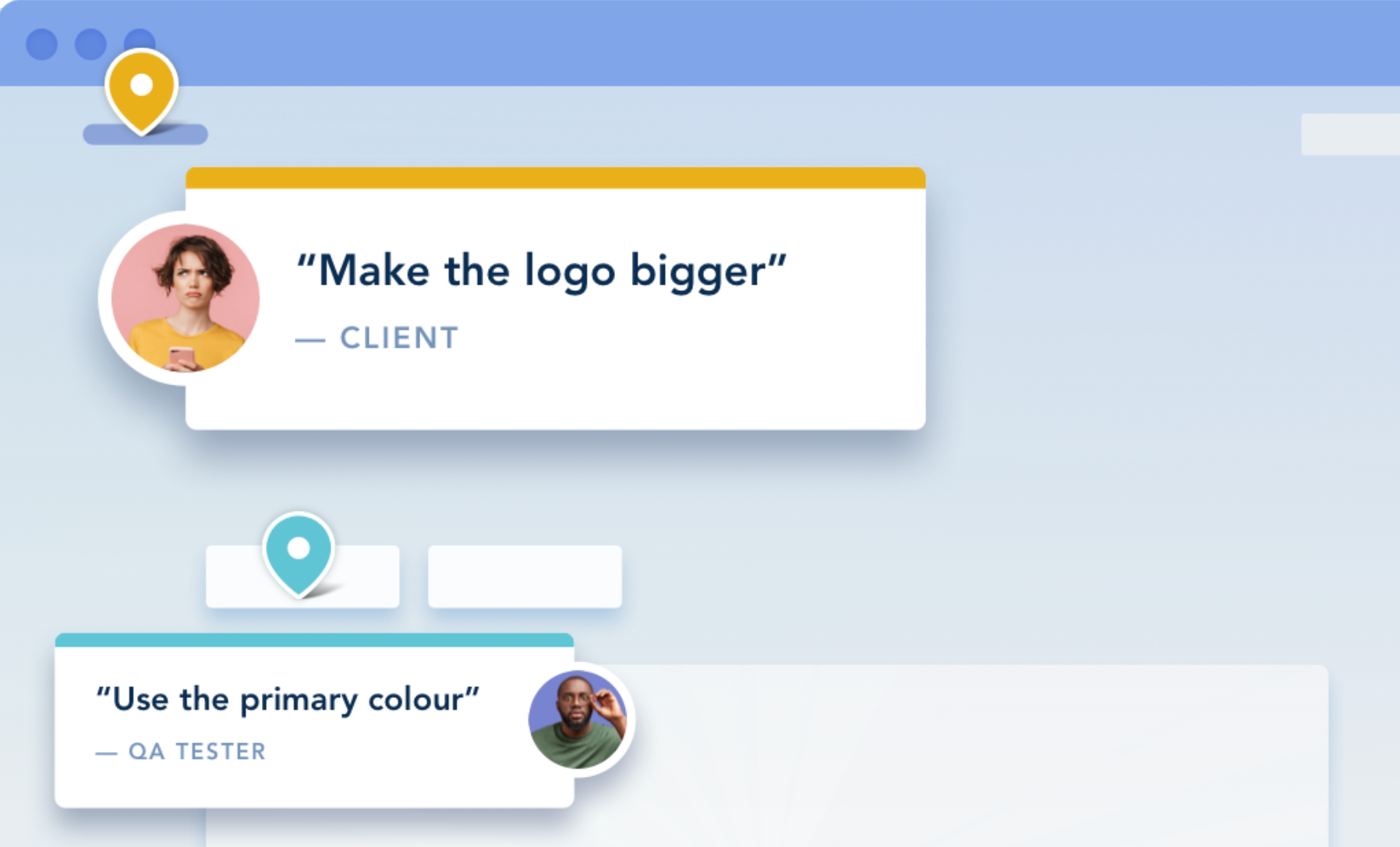It’s tempting to wait until your website prototype has entered the final design phase before requesting client feedback.
But the best time to get your client’s feedback is when the site is still in the early stages of design.
Why so early? Well, fixing design and user experience issues are always less expensive (and less time-consuming) when you address them before writing the back-end and front-end code.
Likewise, changes will require less effort — and be less disruptive to the overall development process — because they won’t affect dependencies like code. Clients and end-users will be happier, too, since you’ll be able to correct issues before it’s too late.
This handy guide will show you how to get the most detailed and useful website feedback from your clients. We’ll also cover several design feedback tools that can help facilitate the process.
Contents:
- Types of Client Feedback For Building Powerful Websites
- Two Methods for Gaining Maximum Insight into Client Feedback
- 6 Website Prototyping and Feedback Tools
- Conclusion
Types of Client Feedback For Building Powerful Websites
Some customers are not always quick to voice their dissatisfaction with a website prototype’s user experience.
That’s why you’ll need to dig deep to get their feedback. You will also need a clear and actionable plan for how you’ll follow through on their demands.
Your teams can use pull user testing data and other feedback to improve your prototype’s visual elements, make stronger design decisions, address overlooked user needs, resolve bugs, and more.
Here are the types of client feedback you need to build a powerful website.
Brand Experience Feedback
Brand experience feedback will be relevant to your website prototype whether you’re building a website for a client, or redesigning your own agency’s website to better convey its brand identity.
Either way, brand feedback should focus on whether the customer thinks the website prototype design is an effective representation of the brand experience.
Let’s say you want to know if your prototype is consistent with the client’s brand personality. Clients know their brand and target market better than anyone — so ask them what they think.
Not only will the client appreciate your attention to detail, they’ll have greater faith in your ability to convey what makes their brand special.
That’s because a website with a consistent brand message can help improve brand awareness in the following ways:
- Consistency: Websites with a consistent brand tone will enjoy more successful marketing efforts.
- Trust: Building consumer trust begins with an on-brand website and product that exudes professionalism and dependability.
- Differentiation: When a website’s design sends a strong and clear brand message, it will set the brand apart from the competition.
- Customer loyalty: By providing a consistent and reliable experience across all touchpoints, it’s easy for an on-brand website to foster customer loyalty.
UX Feedback
Raise engagement and conversion rates by creating a website that centers the user experience.
User experience is just as key to the website design process as brand experience. Conduct usability testing to gain honest feedback about whether the website is easy to navigate, the CTA buttons are prominent enough, or if it’s easy for end users to begin and finish essential tasks.
The goal of UX design is to make a website as easy, efficient, and enjoyable to use as possible. Over time, higher levels of satisfaction and engagement will translate to more site traffic — and higher revenue.
Add the following steps to your project management workflow to obtain, analyze, and apply your clients’ UX-related feedback:
UX research
User research is the foundation of great UX. You need to research the website’s target audience and users to learn about their objectives, needs, motivations, and behaviors.
Surveys, focus groups, interviews, opinion polls, and in-person observation are some of the best UX research methods.
Analysis and sorting
Now that you’ve gathered user research data, analyze it to find recurring themes and pain points that are relevant to the website prototype.
Sort comments into categories based on user impact, priority, and applicability to the project. Your UX designer will use this data to develop customer persona — and pinpoint important user segments — which support better product design ideation.
Wireframes
Create a web design blueprint, or wireframe, to sketch ideas for a website layout that embraces the customer personas you identified during user research. Use the wireframes to get early feedback and make any necessary modifications.
Ask your clients to review the wireframes and provide feedback or make a request for a layout change. Later in the article, we’ll cover a few of the tools that you can use to help clients annotate website wireframes and prototypes.
Prototyping
If wireframes are the website blueprints, then prototypes are the three-dimensional models. Think of them as a more realistic, semi-final depiction of the complete website.
Prototyping tools like Figma enable users to create shareable, interactive prototypes. They also support easy collaboration and idea exchange with your stakeholders before the development process starts.
User testing
Next, have your clients or target users interact with the website prototype to test the user experience.
User testing is typically done in person. Observing users can enhance your understanding of their behavior, as well as assist designers when identifying and resolving any pain points that may arise during a user’s interaction with the design.
Implementing solutions
Use the feedback and data obtained from the research process to create the final design for your UX-friendly website.
Design Feedback
Design feedback considers a website’s aesthetic and visual appeal in the eye of the customer.
The layout, fonts, color scheme, and menu navigation are just a few of the critical design features that can influence a website visitor's experience.
Although the debate over the best color schemes and typography is never-ending, you’ll want your client’s feedback because design elements have an outsized impact on the user experience.
At the same time, don’t allow unrealistic client preferences to damage the user experience. A strong, foundational knowledge of UX design principles can help you feel more confident when explaining design decisions to a skeptical client.
You want them to understand that a user-focused design strategy will make their website more attractive to their customers, which leads to higher rates of conversion and engagement.
Related: A Critical Comparison of the Best of the Best Website Feedback Tools

Two Methods for Gaining Maximum Insight into Client Feedback
You’ve shown your client the website prototype and obtained their feedback.
Now, only one question remains. How do you use that feedback to learn more about the client’s needs and desires?
Keep reading to learn about the two methods we recommend for maximizing insight into client feedback.
Use a Feedback Grid to Organize Ideas
Document all client and user feedback — whether positive or negative. Feedback grids, which are a fantastic method for identifying and capturing what users have to say, are one of the easiest ways to track and organize that feedback.
A feedback grid divides your stakeholders’ feedback into four categories:
- What worked well
- What needs to change
- Unanswered questions
- New ideas to try
Use feedback grids during prototype testing to filter comments based on not only whether the feedback is positive or negative, but also the priority of the feedback.
You’ll get insight into what your prototype is doing right, what needs improvement, and what your team should work on first.
Learn more about how to create and use a feedback grid to enhance your website prototype and delight your clients.
Apply the “I Like, I Wish, What If” Format to Capture Insightful Feedback
Use the Stanford approach to encourage clients to frame their feedback in terms of the following opening statements:
- I like...
- I wish…
- What if…
The “I Like, I Wish, What If” approach to feedback has several advantages.
First, it makes client feedback more actionable. Second, it directs the client’s attention toward the positive elements of the project while still offering constructive criticism.
This strategy can improve team communication since it motivates people to offer criticism in a positive and useful way. People can collaborate to make improvements and receive better results by concentrating on what is working well and what could be improved.
Examples of the Stanford approach in action
I Like: "I like the color scheme you chose for the site. It has great visual appeal and embodies our brand personality."
I Wish: "I wish the navigation menu was easier to find. I struggled to find the resources and information I needed."
What If: "What if you added an image gallery to each product page? It could help customers better understand what our products look like."
You Might Like: Best Online Annotation Tools for Client Feedback

6 Website Prototyping and Feedback Tools
1. BugHerd
BugHerd is a highly-rated and user-friendly video and visual feedback tool for web projects.
Use it to gather, organize, and track customer feedback during the staging phase of a website development project. It’s so intuitive that even the most non-technical clients can install and use it with ease.
BugHerd can be installed as a browser extension, or you can directly embed the JavaScript code in your web project. You’ll need to sign up for a BugHerd account or free 14-day trial to invite users and collect feedback.
The tool provides a Kanban-style issue tracking board to help dev teams track and manage customer and QA tester feedback. Users can assign feedback to specific development team members and add priority ratings, descriptive tags, and annotations.
2. Balsamiq
Balsamiq is an easy-to-use wireframing tool that’s best for the early phases of website development.
Anyone can use it to create low-fidelity website mockups, arrange layouts, and organize the flow of critical actions. Users can annotate the wireframes with valuable feedback, which supports the next stage of the design process.
Balsamiq offers both web and desktop versions. The web version is great for on-the-go collaboration while the desktop app supports offline work, reducing reliance on internet connectivity.
3. Axure
Axure is a full-feature design tool for developing user flows, storyboards, customer journey maps, prototypes, and information architecture, as well as low and high-fidelity wireframes. It features an extensive library of components for creating wireframe deliverables.
Like Balsamiq, Axure has desktop and cloud versions. The desktop app comes with a complete library of widgets and design elements. You can also download third-party libraries created by other designers within the Axure community.
This powerful design tool boasts a number of standout features. These include built-in widgets for faster wireframing and prototyping, a drag-and-drop environment, workspace collaboration, and mobile emulation.
4. Mockflow
Use Mockflow to document users’ feature requests and visualize a website prior to development.
MockFlow has an extensive library of icons, stickers, and other design elements for quick and easy wireframing. Users can also access more design libraries with custom UI packs and templates from the Mockstore.
Thanks to its built-in sharing and team chat features, MockFlow makes it easy for designers to work together in real-time.
Note that Mockflow is useful for the low-fidelity wireframing stage of the design process, it is not a substitute for more robust design tools, such as Axure.
5. UXPin
UXPin is a robust UX design tool with prototyping, wireframing, and interactive mockup features.
Collaboration is one of UXPin’s main draws. Users can establish a project workspace to create anything from a low-fidelity wireframe to an interactive website prototype.
This tool can not only simplify how you collect feedback, but also how you conceive early and late-stage designs for client evaluation. Designers, developers, and product managers can collaborate on the fly to generate quality iterations of a web design for feedback and development.
UXPin supports integration with Sketch and Figma, as well as rapid prototyping and customization with a massive library of design elements and tools. Add videos and images for high-fidelity visualizations of a final product.
6. Sketch
Sketch is an intuitive design, prototyping, and collaboration tool for designers. It’s a Mac-only app with all the features you need to create an interactive user interface for client feedback.
Sketch has a semi-auto design assistant, making it easy for non-designers to illustrate ideas. For professional web design agencies, Sketch’s design assistant speeds up the design process, reducing the time between gathering feedback and creating iterations.
Sketch’s design files can be exported in different versions. With Sketch’s infinite canvases, customizable Artboards, and grid settings, you can create a workflow for all design projects.
Conclusion
User feedback is essential for developing websites that exceed client expectations every time.
The design methods and feedback tools we’ve described are relevant to every stage of web development and design. Give your website prototype the finishing touch by using BugHerd to track issues and collect and analyze feedback.
Up Next: How Customer Journey Mapping Informs Better Website Builds


















But don't just take our word for it.
BugHerd is loved by 10,000+ companies,
350,000+ users across 172 countries.
4.8/5
4.7/5
4.5/5
5/5
8.7/10
Sam Duncan 📱📏 🌱
@SamWPaquet
"@bugherd where have you been all my life??
We just migrated our bug tracking over from Asana and have at least halved our software testing time🪳👏📈. "
Ashley Groenveld
Project Manager
“I use BugHerd all day every day. It has sped up our implementation tenfold.”
Sasha Shevelev
Webcoda Co-founder
"Before Bugherd, clients would try to send screenshots with scribbles we couldn't decipher or dozens of emails with issues we were often unable to recreate."
Mark B
Developer
“A no-brainer purchase for any agency or development team.”
Kate L
Director of Operations
"Vital tool for our digital marketing agency.”
Paul Tegall
Delivery Manager
"Loving BugHerd! It's making collecting feedback from non-tech users so much easier."
Daniel Billingham
Senior Product Designer
“The ideal feedback and collaboration tool that supports the needs of clients, designers, project managers, and developers.”
Chris S
CEO & Creative Director
“Our clients LOVE it”
Emily VonSydow
Web Development Director
“BugHerd probably saves us
at least 3-4hrs per week.”